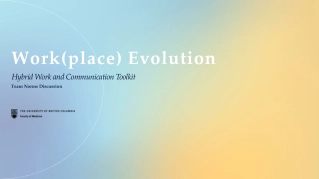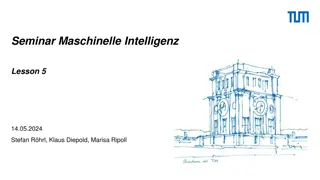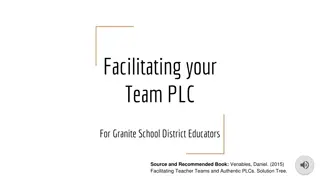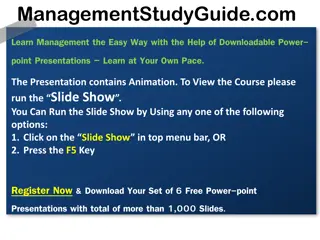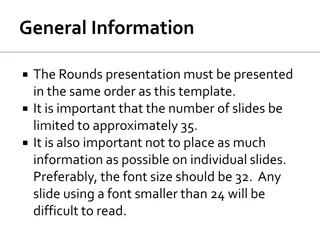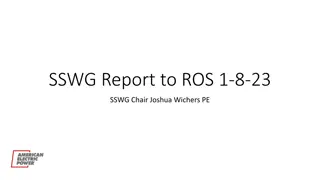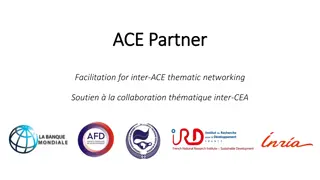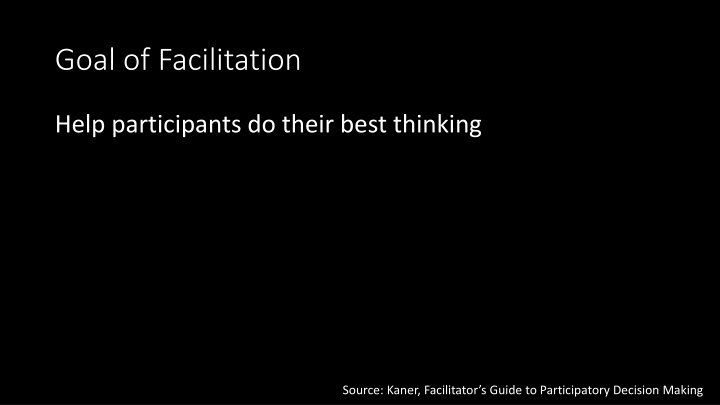
Effective Facilitation for Optimal Decision Making
Facilitation plays a crucial role in helping participants enhance their thinking abilities and reach optimal decisions. Sam Kaner outlines four key functions of facilitation: encouraging full participation, promoting mutual understanding, fostering inclusive solutions, and cultivating shared responsibility. This involves creating an environment where self-censorship is minimized, fixed positions are challenged, win/lose mentalities are shifted towards inclusivity, and reliance on authority gives way to shared responsibility. The practice involves asking discussion questions, seeking more information, probing for opinions, interpreting meanings, critiquing assumptions, and synthesizing common themes.
Download Presentation

Please find below an Image/Link to download the presentation.
The content on the website is provided AS IS for your information and personal use only. It may not be sold, licensed, or shared on other websites without obtaining consent from the author. If you encounter any issues during the download, it is possible that the publisher has removed the file from their server.
You are allowed to download the files provided on this website for personal or commercial use, subject to the condition that they are used lawfully. All files are the property of their respective owners.
The content on the website is provided AS IS for your information and personal use only. It may not be sold, licensed, or shared on other websites without obtaining consent from the author.
E N D
Presentation Transcript
Goal of Facilitation Help participants do their best thinking Source: Kaner, Facilitator s Guide to Participatory Decision Making
Sam Kaner on Facilitation: Four Functions of Facilitation
Sam Kaner on Facilitation: Four Functions of Facilitation 1. Self-Censorship Encourage Full Participation
Sam Kaner on Facilitation: Four Functions of Facilitation 1. Self-Censorship Encourage Full Participation 2. Fixed Positions Promote Mutual Understanding
Sam Kaner on Facilitation: Four Functions of Facilitation 1. Self-Censorship Encourage Full Participation 2. Fixed Positions Promote Mutual Understanding 3. Win/Lose Mentality Foster Inclusive Solutions
Sam Kaner on Facilitation: Four Functions of Facilitation 1. Self-Censorship Encourage Full Participation 2. Fixed Positions Promote Mutual Understanding 3. Win/Lose Mentality Foster Inclusive Solutions 4. Reliance on Authority Cultivate Shared Responsibility Source: Kaner, Facilitator s Guide to Participatory Decision Making
1. Ask Discussion Question 2. Ask Follow-up Questions (or paraphrase, summarize, etc.)
1. Ask Discussion Question 2. Ask Follow-up Questions (or paraphrase, summarize, etc.) Elaborate Seek more or different information React Probe for opinions and values Interpret Explore meaning and significance Critique Challenge evidence, reasoning, or assumptions Synthesize Develop common themes
1. Ask Discussion Question 2. Ask Follow-up Questions (or paraphrase, summarize, etc.) Elaborate Seek more or different information React Probe for opinions and values Interpret Explore meaning and significance Critique Challenge evidence, reasoning, or assumptions Synthesize Develop common themes 3. Repeat
Specific Facilitation Techniques Paraphrasing Summarizing (Drawing out Key Themes) Tracking Making Space for Quiet People Empathizing Intentional Silence Listening for the Logic Listening for Common Ground Source: Kaner, Facilitator s Guide to Participatory Decision Making
Q: Whats most valuable about prioritizing arts programs in high schools?
Q: Whats most valuable about prioritizing arts programs in high schools? 1. I mean, I guess I just like it because it means kids get to do art.
Q: Whats most valuable about prioritizing arts programs in high schools? 1. I mean, I guess I just like it because it means kids get to do art. And why do you find that to be important?
Q: Whats most valuable about prioritizing arts programs in high schools? 1. I mean, I guess I just like it because it means kids get to do art. And why do you find that to be important? 2. I guess creativity and self expression are not really emphasized in other school subjects, so they need to be possible somewhere.
Q: Whats most valuable about prioritizing arts programs in high schools? 1. I mean, I guess I just like it because it means kids get to do art. And why do you find that to be important? 2. I guess creativity and self expression are not really emphasized in other school subjects, so they need to be possible somewhere. 3. Yeah, I think it s important for there to be a place for being able to explore other ways of processing things. [long personal example] So I d say that getting beyond merely rational or logical things should be part of our education.
Q: Whats most valuable about prioritizing arts programs in high schools? 1. I mean, I guess I just like it because it means kids get to do art. And why do you find that to be important? 2. I guess creativity and self expression are not really emphasized in other school subjects, so they need to be possible somewhere. 3. Yeah, I think it s important for there to be a place for being able to explore other ways of processing things. [long personal example] So I d say that getting beyond merely rational or logical things should be part of our education. So I m hearing that art is a good thing in its own right, and that being able to develop other parts of our mind is important. Are there other ways that prioritizing arts programs could be valuable?
Q: Whats most valuable about prioritizing arts programs in high schools? A: I know that for a lot of my friends, they maybe weren t great students, but they did enjoy coming to school because of the drama program and the choir. I think it s like what sometimes happens with sports. Kids come to school because they want to do athletics. And maybe there are rules of something where they need to keep their grades up, so they at least got C s. Although sometimes the coaches also were the teachers, and it seemed like maybe they cut them a lot of slack, because they wanted to keep them on the team.
Whats wrong with these facilitating questions? How should teachers help get their students more engaged in school? Why do you think that the number of students who attend public school decreases during the transition from elementary school to high school? Do you think this new policy of zero tolerance of suspension and expulsion is going to work? How can schools instill respect into the classroom to improve learning environments?
Evaluating Facilitation: Task Functions 1. Fosters Depth Helps participants to do their best thinking Encourages deep reflection on benefits and trade-offs; gets beyond surface observations Asks open-ended, focused questions that are relevant to topic
Evaluating Facilitation: Task Functions 1. Fosters Depth 2. Fosters Deliberativeness Resists the tendency to focus initially on what is practical, and instead helps participants to consider what they find valuable Highlights tensions, ambiguity, or gray areas unearthed during discussion Prevents the conversation from becoming a debate
Evaluating Facilitation: Task Functions 1. Fosters Depth 2. Fosters Deliberativeness 3. Maintains Neutrality and Credibility Functions as a facilitator rather than a lecturer or contributor Remains open to alternate solutions, approaches, benefits, and trade-offs that your group might not have considered Cites at least two sources aloud effectively
Evaluating Facilitation: Social Functions 1. Fosters Clarity Draws out key ideas by consistently paraphrasing, summarizing, and tracking key themes Encourages sustained deliberation of a line-of-thought, via follow-up questions
Evaluating Facilitation: Social Functions 1. Fosters Clarity 2. Manages Logistics Manages time so that all elements are given fair consideration (stacking, balancing, linking, summarizing, etc. ) Handles facilitation challenges effectively (disruptions, misinformation, monopolizing participant, slow start to conversation, etc.)
Most common critiques Let conversation get buried in a debate over logistics Most questions sought conjecture (speculation) Lots of yes/no questions Only considered pros (or only considered cons) No paraphrasing, follow-up questions, or summarizing Facilitators shared opinions (didn t remain neutral)
Sample A level feedback Yours was the only group that asked people to really wrestle with the values and the trade-offs we re willing to make. You adapted to participant contributions well on the fly and asked great paraphrasing and follow-up questions. Key themes were drawn out (summarizing), as well. One of the primary reasons that your group was so successful in swaying participants was that you actually let them weigh pros and cons; this helped them consider the approach, as opposed to getting bogged down in the feasibility and logistics of recycling programs or solar energy distribution channels. The other main reason was that, for the first time, people actually saw it as a potentially viable strategy. We d said that this was going to be the real challenge for your approach, and you handled it effectively.


